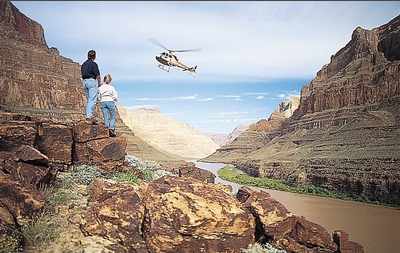Fri, Nov 09, 2007
Says FAA, TOPS Need To More-Closely Monitor Tours
 Spurred on by two
separate accidents involving helicopters conducting air tour
operations over the Grand Canyon, on Thursday the National
Transportation Safety Board issued recommendations to the Federal
Aviation Administration and the Tour Operators Program of Safety
geared towards weeding out problem pilots, before they can cause
accidents.
Spurred on by two
separate accidents involving helicopters conducting air tour
operations over the Grand Canyon, on Thursday the National
Transportation Safety Board issued recommendations to the Federal
Aviation Administration and the Tour Operators Program of Safety
geared towards weeding out problem pilots, before they can cause
accidents.
The Board cites the September 2003 downing of a Sundance
Helicopters AS350 A-Star in Descent Canyon, as well as an accident
two years before involving an AS350 flying for Papillon Airways, as
reasons for the recommendations. Over the course of its
investigations, the NTSB found the pilots involved in both
accidents had received complaints from passengers on previous
flights, stating they had flown recklessly.
Both pilots received complaints they had flown too closely to
canyon walls; in the case of the Papillon pilot, passengers
described incidents where the pilot would deliberately fly towards
a wall, with his head turned to talk with passengers in the back,
"until the passengers screamed for him to turn around" -- as well
as descending steeply "to show passengers what it was like to drive
a car off a cliff."
The NTSB also found those complaints were not addressed by the
respective companies.
Both Sundance and Papillon are enrolled in the Tour Operators
Program of Safety (TOPS). The companies receive independent safety
audits under the program, which also governs flight operations
within strict criteria.
The NTSB recommended the Federal Aviation Administration:
- Require periodic en route surveillance of all repetitively
flown commercial air tour routes in the Grand Canyon area,
including those routes located outside of the Special Federal
Aviation Regulations No. 50-2 airspace. (A-07-89)
- Require all commercial air tour operators to maintain records
of all safety-related complaints and complaint correspondence
regarding pilot performance, document what actions the company took
to address each complaint, and make the records available to the
principal operations inspector for periodic review. (A-07-90)
- Require all commercial air tour operators to maintain the names
and contact information of all passengers, along with the
respective flight's identification number, for at least 30 days
following the flights. (A-07-91)
- Encourage commercial air tour operators to establish a
structured flight operations monitoring program that incorporates
routine reviews of all available sources of information to ensure
that pilots are conducting flights in accordance with company
operating practices. (A-07-92)

In addition, the Board also recommended the Tour Operators
Program of Safety:
- Expand the safety audit program to include a review of records
of all safety-related complaints and complaint correspondence
regarding pilot performance. (A-07-93)
- Expand the safety audit program to include en route
surveillance of all repetitively flown commercial air tour routes
in the Grand Canyon area. (A-07-94)
- Revise the safety audit program guidance materials to include a
clear definition of "air tour flight" to ensure that auditors and
members effectively implement en route surveillance of all air tour
flight routes. (A-07-95)
FMI: Read The Full Recommendations Here And Here (.pdfs)
More News
Takeoff Roll The process whereby an aircraft is aligned with the runway centerline and the aircraft is moving with the intent to take off. For helicopters, this pertains to the act>[...]
“We’re proud of the hard work that went into receiving this validation, and it will be a welcome relief to our customers in the European Union. We couldn’t be mor>[...]
"Aircraft Spruce is pleased to announce the acquisition of the parts distribution operations of Wag-Aero. Wag-Aero was founded in the 1960’s by Dick and Bobbie Wagner in the >[...]
IDENT Feature The special feature in the Air Traffic Control Radar Beacon System (ATCRBS) equipment. It is used to immediately distinguish one displayed beacon target from other be>[...]
Aero Linx: Pararescue Air Force Pararescuemen, also known as PJs, are the only DoD elite combat forces specifically organized, trained, equipped, and postured to conduct full spect>[...]
 ANN's Daily Aero-Term (05.10.24): Takeoff Roll
ANN's Daily Aero-Term (05.10.24): Takeoff Roll Aero-News: Quote of the Day (05.10.24)
Aero-News: Quote of the Day (05.10.24) Aero-News: Quote of the Day (05.11.24)
Aero-News: Quote of the Day (05.11.24) ANN's Daily Aero-Term (05.11.24): IDENT Feature
ANN's Daily Aero-Term (05.11.24): IDENT Feature ANN's Daily Aero-Linx (05.11.24)
ANN's Daily Aero-Linx (05.11.24)




